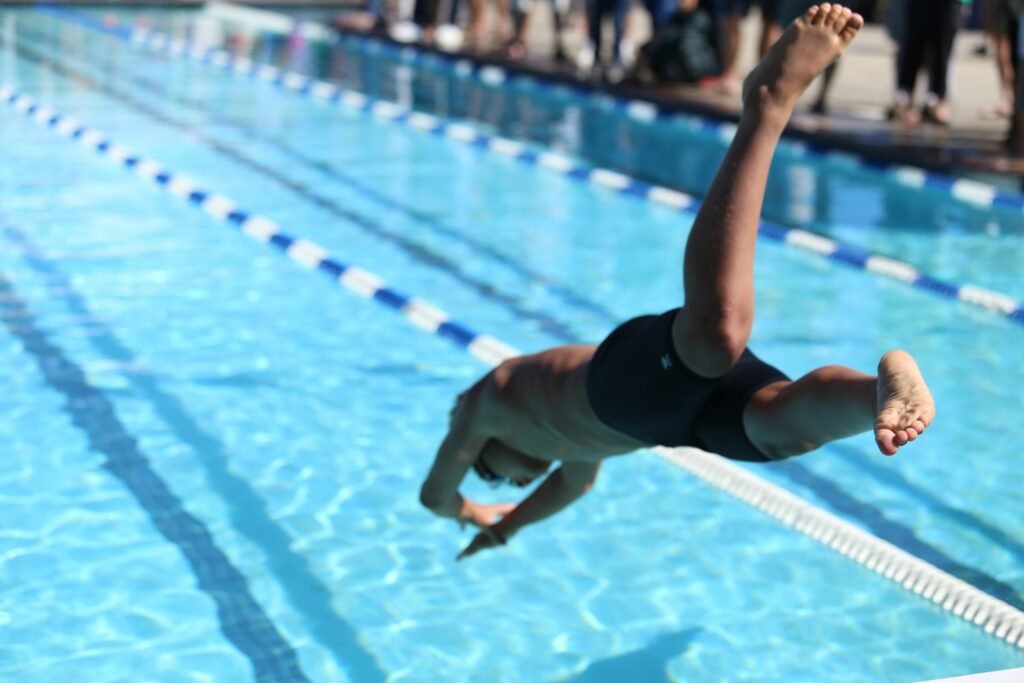A Refreshing Take on Fitness
Are you really tired of the same old gym routine? Are you looking for a workout that’s as much fun as it is effective? Go find a swimming pool and thank me later. Swimming is not just a leisure activity; it’s a powerful, full-body workout that can challenge even the most comprehensive gym session.
Let’s dive into the top 8 reasons why a swimming session outperforms the traditional gym workout.
Full-Body Workout
Swimming engages almost every major muscle group, providing a full-body workout. From shoulders and back to your legs and core, swimming ensures no muscle is left untouched.
- Muscles Worked: Lists of muscles worked in swimming.
| Upper Body | Core muscles | ||
| Deltoids (shoulders) | Rectus Abdominis (front abs) | ||
| Latissimus dorsi (upper back) | Obliques (side abs) | ||
| Trapezius (upper back and neck) | Transverse Abdominis | ||
| Pectoralis major (chest) | Erector Spinae (lower back) | ||
| Biceps & Triceps (front & back of upper arm) |
Apart from these in the list, the calves, glutes, hips, and thighs are thoroughly involved.

Swimming Strokes
- Freestyle :
- Muscles Worked: The freestyle stroke targets the upper body, including the deltoids, latissimus dorsi, trapezius, pectoralis major, biceps, and triceps. It also engages the core muscles such as the rectus abdominis, obliques, transverse abdominis, and erector spinae. The kicking movement works the quadriceps, hamstrings, glutes, calves, and hip flexors. So overall the entire body is worked out in this style of swimming. It is also sometimes referred to as Front Crawl.
- Backstroke:
- Muscles Worked: This one focuses on the upper back muscles like the latissimus dorsi and trapezius. It also engages the deltoids, pectoralis major, and triceps. The kicking action works on the lower body muscles same as in freestyle.
- Breaststroke:
- Muscles Targeted: Breaststroke primarily targets the chest muscles (pectorals), deltoids, triceps, and upper back muscles. The frog-like kicking motion works the inner and outer thighs (adductors and abductors), glutes, and calves. In addition to these, it also engages the core muscles.
- Butterfly Stroke:
- Muscles Targeted: Butterfly stroke is quite a demanding stroke that extensively works the chest, deltoids, triceps, and upper back muscles. The dolphin kick engages the core muscles intensely, including the rectus abdominis, obliques, and erector spinae. It also works the hip flexors, quadriceps, hamstrings, and glutes.
Low Impact Exercise-Swimming
One of the best things of swimming is its low-impact nature, making it great for people with joint problems/arthritis. Unlike running or weightlifting, swimming doesn’t put pressure on your joints.
Expert Opinions: Insights from physical therapists on swimming as rehabilitation
There are quite a few famous personalities who have turned to swimming after experiencing injuries or as part of their rehabilitation process.
One notable example is Michael Phelps, the most loved Olympian of all time. He struggled with attention deficit hyperactivity disorder (ADHD) as a child and found solace in swimming, which eventually became his passion and made him have a successful career in international swimming.
Another great example is Ian Thorpe, an Australian swimmer known for his feats in the Olympics. Thorpe suffered from asthma as a child and started to take swimming as a way to improve his respiratory health. His dedication to the sport helped him become one of the greatest swimmers in history.
As per the Harvard university published stats, the calories burnt while swimming versus running were as follows
| Type of activity (30 mins) | 125 pounds | 155 pounds | 185 pounds |
| Swimming (leisure) | 180 | 223 | 266 |
| Swimming (vigorous) | 300 | 372 | 444 |
| Running (12min/mile) | 240 | 298 | 355 |
| Running (8min/mile) | 375 | 465 | 555 |
Improves cardiovascular health
Swimming increases heart rate without stressing the body, improves circulation, and lowers BP. It’s an amazing way to keep your heart healthy and strong.
Studies and Research: Numerous studies have highlighted swimming’s cardiovascular benefits, including improved heart rate and lower risk of heart disease.As published in an article by Harvard University, one study compared blood pressure, cholesterol levels, maximum energy output, and other measures of cardiovascular health across nearly 46,000 male and female walkers, runners, swimmers, and couch potatoes. People who swam and ran regularly had the best numbers, followed fairly closely by walkers. As expected, nonexercisers had the highest weights and resting heart rates and the worst cholesterol levels and overall fitness.
Enhances Mental Health
Just like any exercise, swimming releases endorphins, which improve mood and decrease anxiety and depression. The calming effect of water makes this even more pronounced in swimming.
The soothing effect of water, combined with endorphin release, makes swimming a fantastic stress reliever.
Boosts Flexibility
Unlike the rigid movements of gym machines, swimming’s fluid motions can significantly enhance your flexibility, especially in your hips, legs, shoulders, and neck.
- Flexibility Comparisons: Swimming regularly demonstrates improvement in flexibility of the body compared to exercises performed using gym machines
- Stretching in Water: Water resistance acts as a natural stretching tool, helping improve your flexibility as you swim.
Suitable for Everyone
Swimming is a universal workout. Whether you’re in the later half of your life, looking for a gentle exercise, a pregnant woman looking for comfort, or an athlete aiming for high-performance training, swimming adapts to your needs.
From children to seniors, swimming offers a unique workout adaptable to any age and fitness level.
Convenient and Enjoyable
Swimming is not only beneficial; it’s also enjoyable. The sense of peace and freedom one feels in water is unequalled. Also, it’s an activity that can be done throughout the year, indoors or outdoors.
Community pools, YMCAs, and health clubs often provide year-round access to swimming pools.
Mix up strokes, join a swimming club or engage in water games to keep your pool time exciting and challenging.

